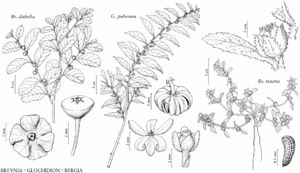Bergia
Mant. Pl. 2: 152, 241. 1771.
| Taxon | Illustrator ⠉ | |
|---|---|---|
 | Glochidion puberum Breynia disticha Bergia texana | Barbara Alongi Barbara Alongi Barbara Alongi |
Herbs [subshrubs], terrestrial [aquatic], glandular-pubescent. Stems ascending to prostrate, solid or pithy, not rooting at nodes [rooting at proximal nodes]. Leaves: stipules nearly membranous; petiole present; blade margins serrulate. Inflorescences usually cymes, rarely flowers solitary. Pedicels present. Flowers: sepals 5, distinct, equal, carinate, apex acuminate or acute; petals 5, apex acute; stamens (5 or 7–) 10; pistil 5-carpellate; ovary 5-locular, apex ± acute; styles 5; stigmas 5. Capsules cartilaginous. Seeds 3–6 [–10] per locule, brown, slightly curved, surface obscurely reticulate with rectangular pits. x = 6.
Distribution
w, c United States, n Mexico, Asia, Africa, Australia, in South America, warm-temperate and tropical regions
Discussion
Species ca. 25 (1 in the flora).
Bergia has its greatest diversity in Africa and Australia.
Selected References
None.